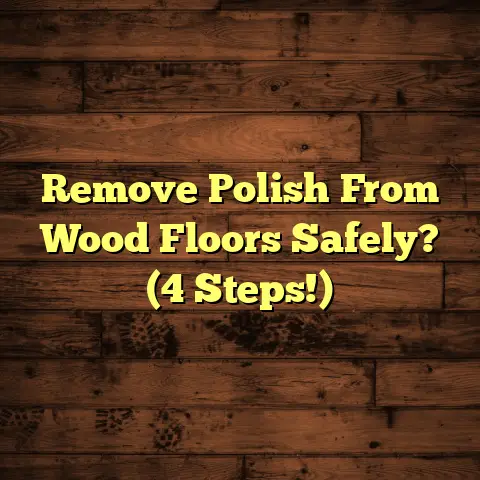Stop Dog Peeing On Tile? (3 Fixes You MUST Know!)
I’ve seen it all, from water damage to warped wood, but one problem that keeps popping up is dog pee on tile.
And believe me, I get it!
A beautifully crafted floor is the foundation of any home, right?
It sets the tone, adds value, and makes your space feel inviting.
But when your furry friend decides to use your pristine tile as their personal potty, it can be incredibly frustrating.
Not only does it create an unpleasant odor, but it can also damage your tile and grout over time.
That’s why I’m here to share my expertise and give you the lowdown on how to stop your dog from peeing on your tile floor.
I’m going to walk you through three essential fixes that blend good pet management with smart home care.
Let’s get started!
Understanding the Problem
Okay, let’s dive into why your dog might be choosing your tile floor as their go-to potty spot.
Comfort is Key: Think about it – tile is cool and smooth, especially during warmer months.
For a dog, that can feel pretty darn good on their paws and belly!
Scent Marking: Dogs communicate through scent, and urine is a major player in their communication game.
If your dog has peed on the tile before, they’re likely to do it again because they can still smell it, even if you can’t.
It’s like leaving a message for other dogs (or even themselves!).
Medical Issues: Sometimes, accidents happen because of underlying health problems.
Urinary tract infections (UTIs), kidney disease, or even just old age can make it harder for your dog to control their bladder.
According to the American Veterinary Medical Association (AVMA), UTIs are a common reason for increased urination in dogs.
Tile’s Impact: The coolness of tile can be really attractive, especially in the summer.
Plus, some dogs simply prefer the feel of it under their paws when they need to go.
Understanding why your dog is doing this is the first step in solving the problem.
It’s not always about disobedience; often, there’s a deeper reason behind it.
Fix #1 – Establishing a
Consistent Routine
A solid routine can make a world of difference in your dog’s potty habits.
Think of it this way: you wouldn’t want to be caught without a bathroom when you need one, and neither does your dog!
Creating a Schedule: The key is consistency.
Set specific times for bathroom breaks, especially after meals, playtime, and naps.
For puppies, that might mean every 2-3
hours.
Adult dogs can usually hold it
longer, but aim for at least 3-4 times a day.
Step-by-Step Guidance:
-
Morning Potty: First thing in the morning, take your dog outside.
-
After Meals: About 20-30 minutes after they eat, head outside again.
-
After Playtime: All that running and jumping can stimulate their bladder.
-
Before Bed: One last trip outside before bedtime can help prevent accidents overnight.
Recognizing the Signs: Learn to read your dog’s body language.
Are they circling, sniffing excessively, or
squatting?
These are all telltale signs that
they need to go.
Don’t ignore them!
Real-World Example: I had a client whose dog, Max, was constantly peeing on their bathroom tile.
We established a strict routine of taking Max out every 3 hours, and within a week, the accidents stopped completely.
It was all about providing him with predictable opportunities to relieve himself.
Fix #2 – Positive Reinforcement Training
Forget yelling or punishment!
Positive reinforcement is the name of the game when it comes to training your dog.
It’s all about rewarding good behavior to encourage them to repeat it.
The Power of Rewards: When your dog urinates outside, shower them with praise, treats, and maybe even a favorite toy.
Make it a party!
The goal is to create a positive association with going potty outside.
Actionable Strategies:
-
Treat Time: Keep a stash of small, tasty treats handy when you take your dog outside.
-
Verbal Praise: Use an enthusiastic tone and say things like “Good potty!” or “Yes, good dog!”
-
Playtime Fun: After they go, engage in a quick game of fetch or tug-of-war.
Timing is Everything: The reward needs to happen immediately after they finish peeing.
We’re talking within seconds!
This helps them connect the action (urinating outside) with the reward (treat, praise, etc.).
Avoid Punishment: Never scold or punish your dog for accidents inside.
This can create fear and anxiety, which can actually make the problem worse.
They might start hiding when they need to go, or they might associate you with negative feelings.
Expert Insight: According to a study published in the Journal of Veterinary Behavior, positive reinforcement is significantly more effective than punishment-based training methods.
Fix #3 – Making the Tile Less Appealing
Alright, let’s get practical and talk about how to make your tile less attractive to your dog’s bladder.
Deterrent Sprays: There are plenty of pet-safe deterrent sprays on the market that have a smell that dogs don’t like.
Look for sprays that contain ingredients like citrus, vinegar, or essential oils.
Application is Key: Spray the deterrent on the tile floor in the areas where your dog tends to pee.
Reapply regularly, especially after cleaning.
Area Rugs and Mats: Cover those tempting tile spots with area rugs or mats.
This not only makes the area less appealing to your dog but also provides a more comfortable surface for them to lie on.
Choosing the Right Rugs: Opt for rugs that are easy to clean and stain-resistant.
You’ll also want to make sure they have a non-slip backing to prevent accidents.
DIY Solutions: Some homeowners swear by using diluted vinegar or lemon juice as a natural deterrent.
However, always test these solutions in an inconspicuous area first to make sure they don’t damage your tile.
Personal Experience: I had a client who tried everything to stop their dog from peeing on their kitchen tile.
Finally, they put down a large area rug, and the problem disappeared overnight.
Sometimes, it’s as simple as changing the texture of the surface!
Additional Tips and Tricks
for Maintaining Tile Flooring
Okay, let’s talk about keeping your tile floors in tip-top shape, even with a furry friend in the house.
Regular Cleaning: This is a no-brainer, but it’s worth emphasizing.
Clean up accidents immediately to prevent staining and odor buildup.
Pet-Friendly Cleaners: Avoid harsh chemicals that can irritate your dog’s skin or respiratory system.
Look for cleaners that are specifically formulated for pet owners.
Sealing Grout Lines: Grout is porous, which means it can easily absorb urine and other liquids.
Sealing your grout lines can help prevent staining and odor.
Choosing the Right Tile: When you’re installing new tile, opt for materials that are less porous and more stain-resistant.
Porcelain and ceramic tiles are generally good choices.
Professional Help: If your tile floors are already stained or damaged, consider hiring a professional cleaning or restoration service.
They have the tools and expertise to get your floors looking like new again.
Industry Standard: According to the Tile Council of North America (TCNA), regular maintenance and proper sealing are essential for extending the life of your tile floors.
Conclusion
So, there you have it!
Three essential fixes for stopping your dog from peeing on your tile floor: establishing a consistent routine, using positive reinforcement training, and making the tile less appealing.
By implementing these strategies, you can maintain the beauty and integrity of your home while also ensuring your dog’s well-being.
It’s a win-win!
Remember, patience and consistency are key.
It may take some time for your dog to adjust to the new routine, but with persistence, you’ll see results.
And don’t be afraid to seek professional help if you’re struggling.
A veterinarian or certified dog trainer can provide valuable guidance and support.
Call to Action
Now, I’d love to hear from you!
What are your experiences with dogs peeing on tile?
Do you have any additional tips or tricks to share?
Leave a comment below and let’s create a community of pet owners who are dedicated to maintaining their homes and nurturing their pets effectively.
Let’s help each other out!





